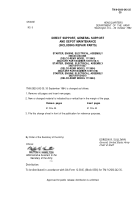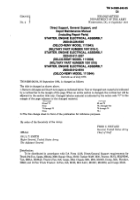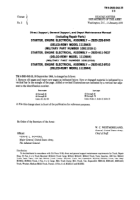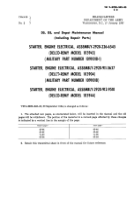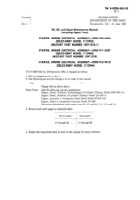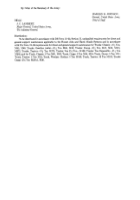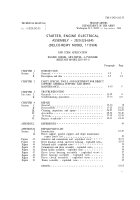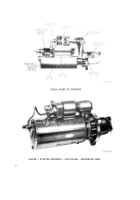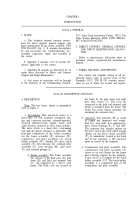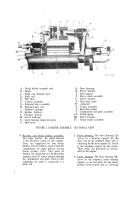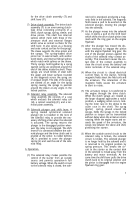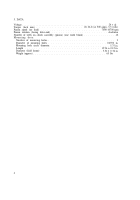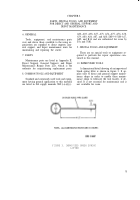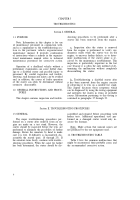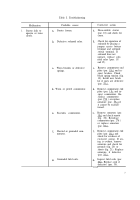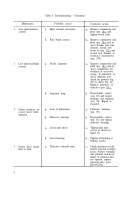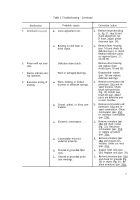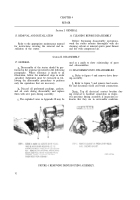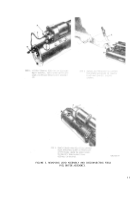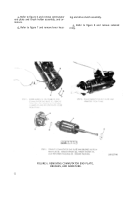TM-9-2920-242-35 - Page 12 of 110
(7)
for the drive clutch assembly (T) and
shift lever (P).
Drive clutch assembly. The drive clutch
assembly (T) is an overrunning clutch-
type drive consisting primarily of a
shell, clutch sprags, spring, sleeve, and
drive pinion. The shell has internal
splines which mesh with those of the
armature shaft and external flanges
which serve as contact surfaces for the
shift lever. It also serves as a housing
and outer contact surface for the sprags.
The sleeve supports the drive pinion and
the sprags. The spring-loaded drive
pinion has 12 external teeth, with another
tooth blank, and internal helical splines
which match with splines on the sleeve.
Thirty sprags, held together by a sprag
(garter) spring are positioned around the
end of the sleeve inside the shell. These
sprags are small billets of steel with
the upper and lower surfaces rounded
so the diagonals across the sprag are
of unequal length. The ends of the sprags
are slotted at an angle for the sprag
spring causing the sprags to position
around the sleeve at any angle, in the
locked position.
(8)
(9)
Solenoid relay assembly. The solenoid
relay assembly (G) consists of a case
which encloses the solenoid relay coil
(H), a contact assembly (F), and a ter-
minal plate assembly.
Solenoid plunger and shift lever. A
spring loaded cylindrical solenoid
plunger (J) is installed in the bore of
the solenoid relay to provide the nec-
essary shifting action when the solenoid
is actuated. The spring returns the
plunger to the disengaged position when-
ever the relay is not engaged. The shift
lever (P) is connected between the sole-
noid plunger and the drive clutch and is
pivoted at the center. A rubber bellows
(K) is provided to cover the plunger
spring (L) and seal the end of the sole-
noid relay.
b. Operation.
(1) The solenoid relay makes possible the
control of the starter from an outside
source and permits operation-h full
battery voltage. When the switch circuit
to the solenoid relay is closed, the sole-
(2)
(3)
(4)
(5)
(6)
noid coil is energized, producing a mag-
netic field in the solenoid. The magnetic
field causes a pull to be exerted on the
solenoid plunger, moving the plunger
into the solenoid.
As the plunger moves into the solenoid
case, it exerts a pull on the shift lever
which shifts the drive clutch pinion into
mesh with the ring gear on the engine
flywheel.
After the plunger has moved the dis-
tance necessary to engage the pinion
with the engine flywheel ring gear, the
end of the plunger presses against the
shaft of the solenoid relay contact as-
sembly. This movement causes the con-
tact disk of the contact assembly to
close the circuit across the battery and
motor terminals of the solenoid relay.
When the circuit is closed electrical
current flows to the starter, forming
magnetic fields about the field coils and
the armature. The interaction of the
magnetic fields causes the armature
to start to rotate.
The armature torque is transferred to
the engine through the drive clutch.
When the clutch sprags are rotated so
the larger diagonal approaches a radial
position, a wedging action occurs, lock-
ing the inner race on the sleeve to the
outer race in the shell. The sprag
(garter)
spring, placed around the
sprags, holds the sprags in the locked
position so torque can be transmitted
without delay when the armature starts
rotating. When the engine starts and ex-
ceeds the speed of the armature, the
sprags slip between the sleeve and shell,
protecting the starter.
When the outside control circuit to the
solenoid relay is broken, the solenoid
circuit is broken. The solenoid plunger
is no longer held by the solenoid and it
is returned to its original position by
spring pressure. This breaks the cir-
cuit to the starter as the contact disk
in the solenoid is moved away from the
battery and motor terminals. At the
same time the shift lever pulls the drive
clutch back to its original position and
the pinion is disengaged from the engine
flywheel ring gear.
3
Back to Top

